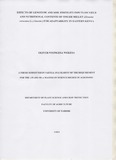| dc.description.abstract | Finger millet has been proposed to be adapted as an option to mitigate climate change against
drought in arid and semi-arid lands. On-farm trials were conducted at Katangi and Katoloni
divisions in Machakos County. In the first objective, twenty finger millet genotypes from
different sources, six local genotypes, six from International Crop Research Institute for
Semi-Arid Tropical (ICRISAT) and eight from Kenya Agricultural Research Institute (KARI)
were screened for , better yields and yield parameters under different soil fertility regimes in
in Eastern Kenya. The experiment was laid out in a randomized complete block design
(RCBD) in a split-plot arrangement replicated thrice. Finger millet genotypes were the main
plot while the three soil fertility regimes (synthetic fertilizer, manure and control) as the subplot.
Genotypes were evaluated for; chlorophyll contents, days to 50% flowering, biomass
contents, plant height, yield and yield components. In the second objective, variation of
nutritional and anti-nutritional contents of finger millet genotypes namely; Ateso, Gulu-E,
KNE-479, KNE-1034, FMV-1 and Nyaikuro was determined. Through specific chemical
analysis procedures, mineral contents, proximately composition and anti-nutritional factors
were determined and correlated.
Chlorophyll content was significantly high (p<0.05) in finger millet planted under synthetic
fertilizer treatment, followed by manure and lowest in control treatment. Similarly, at
Katangi, application of synthetic fertilizer led to increased biomass content followed by
organic manure whereas control had the least.
Finger millet genotypes at Katangi matured earlier by attaining 50% flowering within 72.9
days compared to those at Katoloni that took 90.2 days. Genotype KNE-689, KNE-479 and
FMV-1 matured early than the rest. However, all the finger millet genotypes did not show
any variation in biomass contents at both sites. A high number of fingers per panicle were
observed in synthetic fertilizer treated finger millet genotypes Okhale-1, P-283 and Oreuro;
the lowest number was observes in genotype KNE-479 and FMV-1 at Katoloni. Under
manure treatment, genotypes Aran, KNE-689 and P-283 had the highest numbers of fingers
per panicle while genotypes KNE-814 and FMV-1 had the least. In control treatment, high
numbers of fingers were observed in genotypes KNE-741, U-15 and wimbee. In comparison,
genotype KNE-479 and Oreuro had the lowest. At Katangi, use of synthetic fertilizer and
manure led to significant increase in yield in all genotypes compared to control. Significantly
(PO.05) high yields were observed in genotypes P-283, Aran, Gulu-E and Ateso while
Nanjala Brown, KNE-479 and Oreuro had low yields at Katoloni, in contrast high yields were
observed in synthetic fertilizer followed by manure treated finger millet at Katangi. At
Katoloni, genotypes, P-283, Nanjala Brown, Emarage and MS had higher 100-seed mass
whereas genotypes KNE-1034, KNE-814 and KNE-689 weighed least.
There were no significant (p>0.05) differences in calcium (Ca), iron (Fe) and zinc (Zn)
contents among the genotypes. An inverse relationship among genotypes between fat
contents and crude protein was observed. Genotypes Ateso and Gulu-E had the highest crude
fat contents while KNE-479 had the lowest. In contrast, genotypes KNE-479 and Nyaikuro
had the highest while genotypes Gulu-E and Ateso had low crude protein. Genotype Ateso
followed by FMV-1 and Nyaikuro had high isoleusine, leusine, methionine, threonine and
cysteine amino acid contents. High levels of phenylalanine were observed in genotypes
Nyaikuro and Ateso. Ateso had the highest P-hydroxybenzoic, sinapic and syringic acids,
while Nyaikuro had high ferulic and vanilic acids. Except for genotype KNE-479 with
highest sinapic acid contents, the ICRISAT developed genotypes had the lowest antinutritional
contents. Anti-nutrients tannins, vanilic acid and ferulic acid were negatively | en_US |

